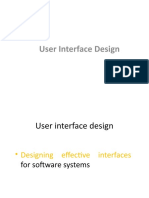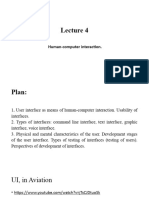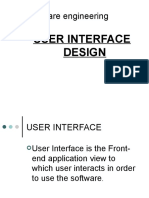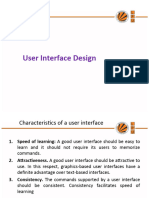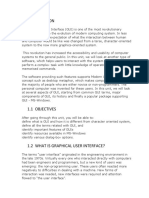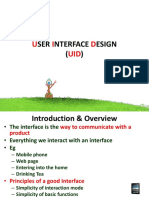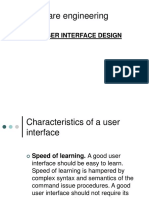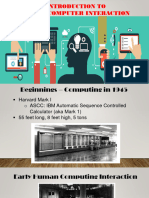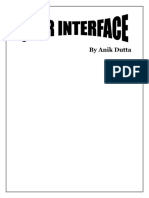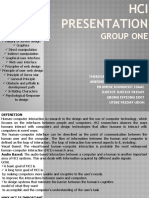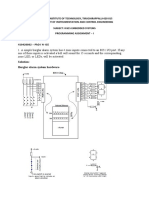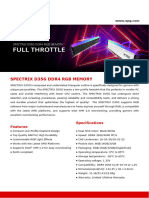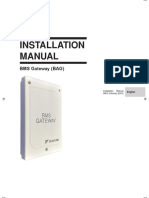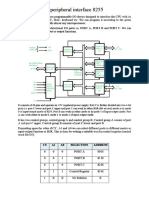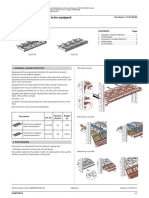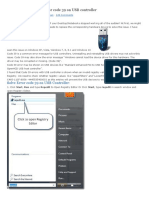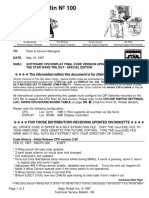TYPES OF USER INTERFACES
Definition of the term: user interface is the means in which a person controls a software
application or hardware device. A good user interface provides a "user-friendly" experience,
allowing the user to interact with the software or hardware in a natural and intuitive way. The
interaction between end-users and the computer is said to take place at the “Human Computer
Interface” (HCI) point. The term “Human Computer Interface” is meant to cover all aspects of
this interaction, not just the hardware.
Software interfaces
Software interfaces would include the use of following:
Command Driven Interfaces
Menu Driven Interfaces
Graphical User Interface
Note: In some situations, two different types of interfaces may be combined, for example, a
menu interface with command options.
Command Driven Interfaces
One of the long-established methods by which user can interact with the computer is by the use
of commands. Commands enable the user to quickly and simply instruct the computer what to
do. However, they require the user to already have knowledge of what commands are
available, what they do and the rules governing how they should be typed, so they are more
suited to experienced users than the end-user. A technical person, such as a computer operator
or programmer would be familiar with the commands, or where the end-user continually works
with the same program and therefore can gain mastery of the commands.
Advantages of command driven interface
1. Faster to use once you have learnt the
commands
2. For a computer programmer command driven
interfaces are cheaper to implement
Disadvantages of command driven interface
1. It is sometimes difficult to remember all the
commands; therefore, users have to
constantly refer to the software user manual.
2. The user is restricted to using only the keyboard as the interfacing device, while with other
interfaces a wide variety of input devices can be used.
1
� 3. Commands must be entered at a special location on the screen and in a set format.
Menu-driven Interfaces
Menus provide another popular form of user interface. There are
many different alternative forms of menu. The simplest menus
provide the user with a number of options and a simple means of
selecting between them. The user is presented with a choice and
therefore does not have to remember any commands. The
interface is therefore suitable for beginners and infrequent users.
All the user has to do is to make a choice.
A special type of menu called a pop-up menu; an additional
submenu pops up as a selection is made. You can click anywhere
on a given document using the right-click mouse button to allow a
pop-up menu to appear.
Pull-down menus are a special type of menu used in windowing and were
briefly introduced. It is a menu displayed as a vertical list which hangs from a
horizontal bar on the screen in order to elicit a choice from the user.
Advantages of menu driven interfaces
1. The user is presented with a list of option to choose from, they do not
need to remember the commands.
2. Free from typing errors, because the user does not have to type the
commands
3. A wide variety of input devices can be used to interface with a menu
Disadvantages of menu driven interface
1. Several steps required to issue a command.
2. Once the user has learned the menu system it is bothersome to have to wait on the
package to present the questions before the commands can be entered.
2
�Graphical User Interface
A Graphical User Interface (GUI, commonly pronounced “guey”) is a Human Computer
Interface (HCI) based upon a graphical display. GUIs are most commonly found on
workstations or PCs fitted with graphics adapters able to support high-resolution graphics. GUI
is a variation of the menu-driven system of selecting commands with the use of the mouse, and
pointers along with the use of windows. Thus, this interface is often summarized using the
acronym WIMP, which stands for windows, icons, menus (“pop-up” and “pull-down”) and
pointers. A mouse is used to click on an icon to execute some operation or select options from a
pop-up or pull-down menu.
Advantages of GUIs
1. Its user friendliness results in less anxiety
on the part of the user.
2. Icons/symbols easier to recognize and
provide the user with a context
3. Fewer command errors
4. Reduce typing
5. Convenient to use by a novice
Disadvantages of GUIs
1. It may consume more screen space
2. For programmers the design of Graphical User Interface is more complex
3. Increase use of computer memory can lead to slower processing
Key Point:
Hardware interfaces
Hardware interfaces are special devices with additional features that will allow interaction
process for the user quite easier.
Hardware interfaces would include the use of following:
touch screens (you learnt about this when we covered input devices)
specialized keyboards – such special keyboards include:
(a) ergonomic keyboards - these keyboards are shaped in a particular manner that is more
comfortable to use. This can assist with the avoidance of injury that may occur during
repetitive usage of the keyboard like typing.
(b) Overlay keyboards – This keyboard replaces the traditional keys with a flat touch-
sensitive panel. These keyboards are very useful for children and adults who cannot
manage a normal keyboard.
(c) Braille Keyboard – these are utilized by blind individuals.
3
� sensors - this is quite useful in providing interfaces for persons who cannot use standard
devices such as keyboards. A user with very limited movement can use a device with a
sensor which they can press with a finger or a foot, or by moving their head.
non-visual interface components – Examples of these interfaces include speech
synthesis and voice recognition.









